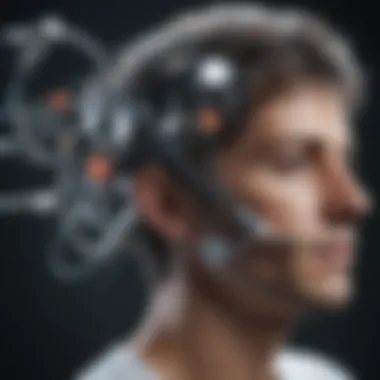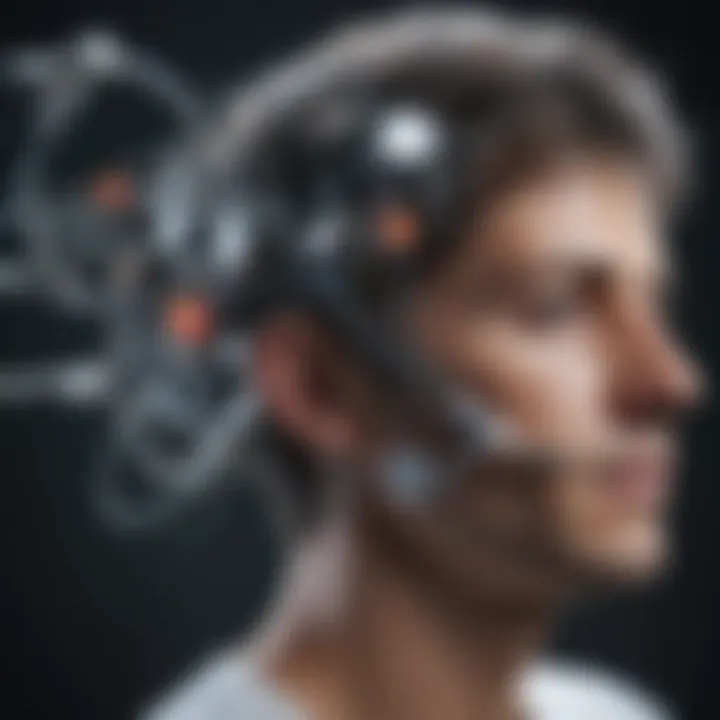Understanding Transcranial Magnetic Stimulation and Its Impact


Intro
Transcranial Magnetic Stimulation (TMS) is emerging as a prominent topic in contemporary neuroscience. The technique offers a non-invasive method for modulating brain activity, attracting interest from both clinical and research perspectives. This article aims to provide a comprehensive overview of TMS, delving into its scientific principles, clinical applications, and ongoing ethical discussions. By synthesizing current findings, we hope to elucidate the multifaceted implications of TMS in treating various neurological and psychiatric disorders.
Understanding TMS requires examining its foundational research and the methodologies that underpin its application. As advancements continue, it becomes essential to assess the significance of these developments and their repercussions in both clinical and societal contexts. This material is particularly relevant for students, researchers, educators, and professionals who seek a deeper comprehension of this innovative tool.
Preface to Transcranial Magnetic Stimulation
Transcranial Magnetic Stimulation (TMS) represents a significant advancement in neuroscience and mental health treatment. This technique utilizes magnetic fields to stimulate nerve cells in the brain. The importance of understanding TMS lies not just in the basic mechanics of its application but in its potential to reshape therapeutic approaches in managing various psychiatric and neurological disorders. With a growing body of research, clarity on TMS’s implications is crucial for professionals in the field.
The benefits of TMS include its non-invasive nature and the ability to target specific areas of the brain. Patients often experience fewer side effects compared to traditional treatments such as medication. For disorders like depression, TMS can provide a viable alternative for those who do not respond to conventional therapies. Additionally, TMS has potential in treating conditions such as obsessive-compulsive disorder and PTSD. Understanding the depth and breadth of TMS enhances the discourse on mental health treatments and offers insights into new avenues for research and clinical practice.
Definition and Mechanism of Action
TMS works by generating brief magnetic pulses that induce electrical currents in targeted brain regions. These currents can modulate neuronal activity, leading to changes in mood and behavior. The procedure is generally well tolerated and is typically conducted in outpatient settings. During a session, the patient wears a cushioned helmet fitted with the TMS device, which is positioned close to the scalp. The precise placement of the coil is crucial, as it dictates the areas of the brain being stimulated.
The mechanism of action for TMS involves increasing the activity of neurotransmitters like serotonin and dopamine, which play significant roles in mood regulation and emotional responses. This stimulation can lead to improvements in depressive symptoms, making it an attractive option for treatment.
Historical Context
The development of TMS can be traced back to the late 20th century, particularly to 1985 when the first human studies were conducted. Since then, TMS has evolved significantly. Initially utilized for research purposes, it began to transition into clinical practice for psychiatric disorders in the 2000s. Early studies focused on the effects of TMS on mood disorders, and in 2008, the U.S. Food and Drug Administration (FDA) approved TMS for treatment-resistant depression.
This historical evolution reflects the broader trends in neuroscience and mental health treatment. As knowledge of brain function has expanded, so too has the interest in non-invasive techniques like TMS. Research continues to explore its full potential and refine techniques for better efficacy, making TMS a focal point of contemporary psychiatric treatment.
Scientific Basis of TMS
Understanding the scientific basis of Transcranial Magnetic Stimulation (TMS) is essential for grasping how it impacts both research and clinical practices. TMS operates through specific mechanisms that make it a unique tool in neuroscience and therapy. Recognizing these foundations allows anyone working in related fields to appreciate the nuances of TMS, as well as its implications for patient care and future research directions.
Neuroscience Underpinnings
The neuroscience underpinning TMS involves its capacity to modulate neuronal activity without invasive procedures. TMS primarily utilizes magnetic fields to induce electrical currents in the brain. This method is based on Faraday's law of electromagnetic induction, where a changing magnetic field can produce electric fields. It targets cortical areas to stimulate neuronal firing. This very concept operates on the principle that neuroplasticity can be enhanced or modulated.
TMS effectively offers the possibility of non-invasive intervention in brain functions. Neurological studies suggest that TMS can either increase or decrease activity in certain areas of the brain, depending on the stimulation frequency. For instance, high-frequency stimulation may elevate excitability in the targeted neural region, while low-frequency stimulation tends to suppress it. These effects are particularly relevant in the treatment of various mental health disorders, as they allow for tailored approaches based on individual patient needs.
It is crucial to understand that the individualized response to TMS can vary significantly among patients. Genetic factors, existing medical conditions, and even personal history may influence treatment outcomes. Thus, tthe neuroscience behind TMS is not only about activation but also about understanding interaction dynamics within neural circuits.
Biophysical Principles
The biophysical principles related to TMS focus on the exact operations of the equipment and how different settings can affect outcomes. TMS employs a coil made of wire through which high electrical currents flow, producing a strong magnetic field. When placed on the scalp, this magnetic field penetrates the skull and generates electrical currents in the underlying brain tissue.
The following points highlight essential biophysical principles:
- Electromagnetic Field Generation: The coil configuration (e.g., figure-eight or circular) significantly affects where the magnetic field will exert its effects in the brain.
- Stimulation Intensity: The amount of current and the duration of pulses can be adjusted, which allows for control over the strength and area of stimulation.
- Frequency of Pulses: The rate at which pulses are delivered is critical; different frequencies lead to different types of neural responses.
Understanding these principles enhances treatment tailorability and efficacy assessment. Moreover, it leads to innovations in device design that may impact efficacy and safety. TMS’s biophysical aspects open a path to deeper exploration into optimizing treatment protocols and understanding the range of possible clinical applications for conditions currently treated with TMS.
"The efficacy of TMS lies as much in its scientific underpinnings as in its clinical applications. Understanding these bases allows practitioners to innovate and improve patient outcomes."
Clinical Applications of TMS
The significance of clinical applications of Transcranial Magnetic Stimulation (TMS) lies in its potential to offer relief to patients suffering from various psychiatric and neurological conditions. TMS represents a shift from traditional treatment modalities, providing a non-invasive alternative with fewer side effects compared to pharmacological therapies. Understanding these applications is essential for both practitioners and patients who seek more effective options in mental health and neurology. By exploring these avenues, we can further grasp how TMS integrates into clinical settings, its efficacy, and the long-term benefits for particular disorders.
Depression and Anxiety Disorders
TMS has emerged as an effective treatment for major depressive disorder. Many patients experience significant improvements after several sessions. One key advantage is that TMS can target brain regions involved in mood regulation. Specifically, the left prefrontal cortex often shows alterations in activity. By stimulating this area, research suggests we can help restore balance in mood-related pathways.
In addition to depression, TMS is also explored as a treatment for anxiety disorders. Studies illustrate that TMS may decrease anxiety symptoms by modulating hyperactive neural circuits. As anxiety varies across individuals, TMS offers a tailored approach that adjusts treatment based on specific needs.
Obsessive-Compulsive Disorder
Obsessive-Compulsive Disorder (OCD) presents unique challenges in treatment. TMS has been studied for its efficacy in reducing obsessive thoughts and compulsive behaviors. The treatment often focuses on the anterior cingulate cortex and other areas implicated in OCD. Clinical trials show promising results, with a subset of patients reporting decreases in symptom severity after TMS.
Moreover, the non-invasive nature of TMS makes it a viable option for patients who do not respond well to standard treatments such as SSRIs or cognitive-behavioral therapy. This expands treatment possibilities and provides hope for those looking for alternatives.


Post-Traumatic Stress Disorder
Post-Traumatic Stress Disorder (PTSD) cases can be particularly debilitating. TMS is gaining traction as a treatment option for PTSD patients who do not find relief through conventional therapies. By acting on the limbic system structures, TMS can help alleviate hyperarousal symptoms and intrusive thoughts.
Studies indicate that patients exposed to TMS may show reduced flashbacks and anxiety levels. The adaptability of TMS protocols allows clinicians to adjust treatments based on how individuals respond, making it a promising method as part of a broader therapeutic plan.
Neurological Conditions
Beyond psychiatric disorders, TMS holds potential for numerous neurological conditions. For instance, it has been utilized in post-stroke rehabilitation, where it may enhance recovery by promoting neuroplasticity in affected areas of the brain. Studies suggest that TMS can help improve motor function and cognitive abilities in these patients.
Additionally, TMS is applied in the management of chronic pain conditions like fibromyalgia and migraines. By targeting specific pain pathways, TMS can lead to a reduction in pain perception and overall improvement in quality of life.
In summary, the clinical applications of TMS extend over a broad spectrum, illustrating its versatility in addressing both psychiatric and neurological disorders. Each application is underpinned by a growing body of research that supports its efficacy. As TMS technology evolves, its capacity to serve diverse patient populations will continue to expand, prompting ongoing investigation into its effectiveness and safety.
"TMS represents a novel frontier in the treatment of various mental health and neurological disorders, expanding options for patients and clinicians alike."
Utilizing TMS not only emphasizes the advancement of medical treatment but also highlights the need for continued exploration in this promising field.
TMS Methodology
The methodology of Transcranial Magnetic Stimulation (TMS) plays a crucial role in both its application and effectiveness. Understanding the methodologies is essential for practitioners and researchers alike. Various factors influence the outcome of TMS sessions; they contribute to how well this technique can address specific neurological and psychological conditions. The effectiveness of TMS is not just reliant on the technology or protocols employed; it also depends on the nuances of the methodologies used during treatment. This section explores three important aspects: types of TMS protocols, techniques and equipment for administering TMS, and the treatment parameters and structure of sessions.
Types of TMS Protocols
Different TMS protocols exist to target various conditions and symptoms.
- Repetitive TMS (rTMS): This is the most common form of TMS used in clinical practice. It involves the repeated delivery of magnetic pulses to stimulate neurons. This protocol is often used for depression and anxiety disorders.
- Theta Burst Stimulation (TBS): TBS is a newer protocol that delivers short bursts of stimulation. It can be more efficient in terms of time and may offer faster relief from symptoms.
- Deep TMS: This protocol utilizes a specialized coil that can reach deeper brain structures, potentially treating conditions that may not respond to standard rTMS.
- Single Pulse TMS: Primarily used for mapping brain function. It allows researchers to pinpoint specific brain areas responsible for certain functions.
Choosing the right protocol depends on multiple factors, including the patient’s specific condition, symptoms, and treatment goals.
Administering TMS: Techniques and Equipment
Administering TMS effectively requires careful attention to techniques and the right equipment. The equipment typically includes a magnetic coil placed on the scalp. The coil generates magnetic fields that induce small electrical currents in the brain. Here are some important considerations:
- Coil Positioning: Properly positioning the coil is key to targeting the right brain areas. This can vary based on the treatment protocol used.
- Calibration of Equipment: Ensuring that the equipment is calibrated correctly to deliver the appropriate intensity of magnetic pulses enhances treatment efficacy.
- Operator Expertise: The practitioner’s knowledge and experience are paramount. They must be well-trained in TMS techniques and understand how to adjust treatment based on patient response.
It is important for clinics to invest in quality equipment and provide training for staff to maintain high standards of care.
Treatment Parameters and Session Structure
The parameters and structure of TMS sessions can greatly affect outcomes and patient experiences. Key elements include:
- Session Length: Common session lengths typically range from 20 to 40 minutes, depending on protocol and individual needs.
- Frequency of Sessions: Most patients receive sessions multiple times per week, often for several weeks. The specific frequency varies based on treatment goals and patient responses.
- Intensity of Stimulation: The intensity is often tailored to each patient’s needs. Adjustments may be made based on how they respond to treatment to optimize effectiveness.
"The precision in treatment parameters is essential for optimizing Transcranial Magnetic Stimulation efficacy across various conditions."
Understanding the methodology of TMS ensures that it can be applied effectively, leading to better outcomes for patients. This encapsulates the importance of methodologies and the detailed elements involved in TMS treatment.
Efficacy of TMS
The efficacy of Transcranial Magnetic Stimulation (TMS) is a critical aspect of understanding its role in modern psychiatry and neurology. As a non-invasive method to modulate neural activity, TMS provides a promising alternative to traditional treatments like medication and psychotherapy. It is essential to evaluate the effectiveness of TMS not only in clinical trials but also through long-term studies that observe results over time. This examination helps establish TMS as a viable treatment option and informs physicians and patients alike about its potential benefits and limitations.
Evidence from Clinical Trials
Numerous clinical trials have been conducted to assess the efficacy of TMS in treating various conditions such as depression, anxiety, and schizophrenia. A range of studies shows that TMS can lead to significant improvement in symptoms for some patients who do not respond to standard medications. For instance, the FDA has approved rTMS for major depressive disorder based on robust clinical evidence.
Key findings from clinical trials include:
- Symptom Reduction: Many patients experience a decrease in depressive symptoms following TMS treatment.
- Response Rates: Research has demonstrated a response rate of approximately 50-60% in individuals with treatment-resistant depression after a series of TMS sessions.
- Rapid Onset of Action: Some studies report that patients begin to see improvement within the first few treatments, unlike traditional antidepressants that may take weeks.
"Transcranial Magnetic Stimulation offers a novel approach in treating resistant cases, providing hope for many who suffer from severe psychiatric disorders."
These clinical results underscore the importance of continued exploration in the successes of TMS. Evaluating its effectiveness against various disorders gives researchers a clearer picture of its advantages and areas for improvement.


Long-term Effects and Follow-up Studies
Assessing the long-term effects of TMS adds another layer to its efficacy analysis. Most follow-up studies indicate that the benefits of TMS can be sustained over time, especially with periodic maintenance treatments. The durability of symptom relief prompts further interest in this technology.
Significant points regarding long-term studies include:
- Sustained Benefits: Participants often retain improvement in their mental health for months following their last TMS session.
- Need for Maintenance: Some patients may benefit from ongoing maintenance treatments to sustain positive effects.
- Quality of Life Improvements: Long-term studies not only measure symptom reduction but also investigate enhancements in overall quality of life.
Research suggests that the long-lasting effects of TMS contribute to positive changes in cognitive and emotional functioning. Ongoing studies will continue to explore how different factors, such as treatment frequency and duration, can further optimize outcomes for individuals receiving TMS.
Comparative Analysis of TMS with Other Treatments
The comparative analysis of Transcranial Magnetic Stimulation (TMS) with other treatment modalities is a significant component of the discourse surrounding mental health therapies. This comparison serves several purposes; it highlights the unique features of TMS while placing its effectiveness in the broader context of available treatments. Understanding how TMS aligns with or diverges from established therapies is crucial for both practitioners and patients when making informed treatment decisions. This analysis not only reflects on efficacy but also considers secondary factors, such as side effects, accessibility, and patient compliance.
Medication-Based Treatments
Medication treatments for mental health conditions traditionally include antidepressants, antipsychotics, and mood stabilizers. These pharmacologic routes often serve as first-line interventions.
- Efficacy: Many studies show that medications can effectively reduce symptoms of depression and anxiety. However, response rates vary among individuals, and full remission is often elusive.
- Side Effects: Common side effects for medication treatments can include weight gain, sexual dysfunction, and gastrointestinal disturbances. Sometimes these effects lead patients to discontinue treatment.
- Speed of Action: Medications often take weeks to demonstrate effects, while TMS can produce quicker results for some patients, sometimes after just one session.
In contrast, TMS directly modulates brain activity without the systemic impact of pharmaceuticals, making it appealing for individuals seeking alternatives or those who have not found relief from medications.
Psychotherapy Techniques
Psychotherapy, including cognitive-behavioral therapy (CBT) and interpersonal therapy (IPT), has been a cornerstone of mental health treatment.
- Cognitive Effects: Psychotherapy aims to change thought patterns and behaviors, which can lead to lasting change. Insightfulness and self-awareness can develop over time.
- Duration: Sessions generally span several weeks or months. Effectiveness is highly dependent on patient-practitioner rapport, and some people require different therapeutic styles before finding what works.
In terms of TMS, it can complement psychotherapy by alleviating symptoms quickly, enabling therapists to focus on deeper cognitive work. By shifting brain function rapidly, TMS may create an environment conducive for psychotherapy to be more effective.
Electroconvulsive Therapy
Electroconvulsive therapy (ECT) is a more invasive treatment that is typically reserved for severe treatment-resistant depression or conditions requiring rapid symptom relief.
- Effectiveness: ECT has a substantial success rate, often more so than medications for severe cases. However, it is not commonly considered a first-line treatment due to its invasive nature.
- Side Effects: Risks include memory loss and confusion, which can be particularly concerning for patients.
TMS distinguishes itself from ECT by being non-invasive and avoiding anesthesia. The side effects of TMS are considerably milder and less disruptive. Many prefer TMS as it has a better safety profile and fewer negative impacts on daily life.
TMS might not replace traditional treatments but may serve as an excellent adjunct in many cases. Understanding its position relative to established modalities is crucial for informed clinical choices.
The comprehensive analysis of these treatment landscapes reveals that TMS occupies a unique niche. More patients are seeking lower-risk options that maintain functionality in their everyday lives. A comparative investigation aids clinicians in tailoring treatment plans and addressing patient concerns effectively.
Ethical Considerations in TMS Research and Practice
The implementation of Transcranial Magnetic Stimulation (TMS) raises various ethical questions, which must be addressed to ensure responsible research and practice. Ethical considerations are crucial not only for protecting patient rights but also for maintaining public trust in neurostimulation technologies. This section explores the dynamics between clinical practice and ethical principles, focusing on informed consent, patient autonomy, potential risks, and side effects associated with TMS treatment.
Informed Consent and Patient Autonomy
Informed consent is a cornerstone of medical ethics, particularly in TMS. It ensures that patients fully understand the treatment process, including the potential benefits and risks associated with TMS. Obtaining informed consent goes beyond a mere signature on a document; it requires thorough communication between the healthcare provider and the patient. Physicians must explain the procedures, possible outcomes, and the scientific basis behind TMS, enabling patients to make educated decisions regarding their treatment options.
Additionally, patient autonomy must be respected at all stages of treatment. Patients have the right to decline or withdraw consent at any time, without facing repercussions. This level of respect fortifies the therapeutic relationship, allowing for open discussions about the treatment’s relevance to the patient's specific condition.
Potential Risks and Side Effects
While TMS is generally considered safe, it is vital to acknowledge the potential risks and side effects to foster a transparent therapeutic environment. Side effects can range from mild to severe, including:
- Headaches
- Scalp discomfort
- Dizziness
- Mood changes
- Hearing issues (where auditory stimulation is involved)
Serious risks, although rare, include the potential for seizures. Healthcare professionals need to screen patients thoroughly for risk factors that may increase the likelihood of adverse reactions. Patients should also be informed of these risks prior to treatment.
A comprehensive discussion about potential side effects fosters trust and allows patients to weigh the benefits of TMS against its risks. Ethical practice dictates that any risks must be communicated clearly, accompanied by strategies to mitigate these risks during treatment.
Ethical considerations are not merely regulatory annoyances; they are the bedrock of a compassionate, patient-centered approach in TMS research and practice.


Engagement in continual research and adherence to ethical standards will assure that TMS remains a beneficial option for those seeking treatment. The intersection of technology and ethics is essential as TMS continues to evolve, highlighting the need for ongoing discourse and careful consideration of patient welfare.
Technological Advancements in TMS
The landscape of Transcranial Magnetic Stimulation (TMS) is rapidly evolving, driven by technological innovations that enhance its efficacy, accessibility, and safety. This section discusses the significance of these advancements, focusing on novel devices and their integration with neuroimaging. These improvements are critical not only for advancing scientific understanding but also for transforming clinical practice. The ongoing evolution in TMS technology directly affects how patients receive care and how researchers study its effects.
Innovative TMS Devices
Recent years have seen the introduction of several innovative TMS devices that have transformed treatment protocols. Many new systems are designed with patient comfort in mind, employing lightweight and quieter designs to alleviate common concerns during treatment. One notable device is the CoolTMS, which uses sophisticated cooling systems to maintain smoother performance and minimize headaches caused by traditional devices.
Additionally, there are portable TMS devices that allow for more flexible treatment options. For instance, the Neuronetics NeuroStar, offers an outpatient treatment option that caters to individuals who may not wish to commit to extensive hospital-based sessions. This has profound implications for patient adherence and satisfaction as more patients can receive TMS in familiar environments.
The targeting accuracy has also improved with the integration of advanced algorithms. Devices now utilize real-time feedback mechanisms that adjust stimulation parameters while monitoring the patient's response. This adaptive approach not only enhances efficacy but also minimizes the risk of adverse effects.
- Enhanced patient comfort and convenience.
- Improved targeting algorithms and precision.
- Portable devices offering more treatment options.
Integration with Neuroimaging Techniques
The intersection of TMS with neuroimaging techniques represents a significant leap in understanding brain function and dysfunction. By integrating functional MRI (fMRI) or electroencephalography (EEG) with TMS, researchers can visualize the brain regions impacted by stimulation in real time. This combination allows for a deeper analysis of how different brain areas cooperate during task performance.
Such integration paves the way for conducting more refined studies on the effects of TMS across various brain networks. For example, researchers can assess how targeting specific areas correlates with changes in behavioral outcomes. It also facilitates the development of personalized treatment plans by mapping an individual's unique brain activity patterns before TMS sessions.
"The synergy between TMS and neuroimaging techniques fundamentally alters our approach to psychiatric and neurological conditions, offering a more nuanced understanding of treatment effects."
Future Directions in TMS Research
The field of transcranial magnetic stimulation, or TMS, is rapidly evolving, and understanding its future directions is critical for both practitioners and researchers. The significance of exploring future directions in TMS research lies in the ongoing quest to enhance its effectiveness, expand its applications, and ensure the safety and ethical considerations are met. This section will focus on how developments in research can open new avenues for TMS, addressing unmet medical needs and potentially offering innovative treatment options for various conditions.
Expanding Clinical Applications
As TMS technology advances, one of the most crucial aspects is the expansion of its clinical applications. Currently, TMS is primarily used in the treatment of depression, anxiety, and certain neurological disorders. However, ongoing research aims to uncover new therapeutic avenues. These may include:
- Chronic Pain Management: Emerging studies are investigating TMS for its potential to alleviate chronic pain, a condition that affects millions worldwide.
- Substance Use Disorders: Some preliminary trials suggest that TMS could help in reducing cravings and the urge to use substances, offering a new pathway for addiction treatment.
- Cognitive Enhancement: Research is also examining the use of TMS in enhancing cognitive functions such as memory and attention, especially in individuals with cognitive impairments.
The potential for TMS to address a broader spectrum of mental health and neurological issues is enormous, which underscores the need for further investigation and clinical trials.
Such expansions not only promise to diversify the applications of TMS but also stand to significantly benefit patients who have not responded well to traditional therapies. This will inevitably lead to a greater understanding of the neurophysiological mechanisms behind TMS.
Global Perspectives on TMS Use
Global perspectives on the use of TMS highlight the multi-faceted approach to its development and implementation across different cultures and healthcare systems. There are noteworthy differences in how countries perceive and integrate TMS in clinical settings:
- Regulatory Approaches: Different countries have varying regulatory frameworks for TMS devices and treatments. In some regions, TMS is widely accepted and integrated into psychiatric practices, while in others, it may be subject to stricter regulations. Understanding these differences is vital for international collaborations.
- Cultural Acceptance: Cultural attitudes toward mental health treatment can influence the adoption of TMS. In some cultures, alternative methods may be preferred over technology-based treatments. Research needs to address these cultural factors to facilitate broader acceptance of TMS as a viable treatment option.
- Access to Technology: The availability of TMS technology differs significantly around the globe. In developed countries, access is generally more widespread, while in developing regions, there may be barriers. Addressing these gaps can lead to more equitable healthcare.
As TMS continues to develop, it is essential for researchers and clinical professionals to consider these global perspectives. They will not only shape the future research landscape but also ensure that the benefits of TMS can be experienced by a wider population, ultimately leading to improved health outcomes.
Epilogue
In this article, the conclusion highlights the significant aspects of transcranial magnetic stimulation (TMS) and its impact on various clinical domains. Recognizing that TMS stands as a non-invasive intervention, it prompts crucial discussions about its role in treating mental health disorders and neurological conditions. The convergence of theory and practice is vital for maximizing the benefits that TMS offers.
Summary of Findings
The findings presented indicate that TMS has shown promise in addressing several psychiatric and neurological disorders. Clinical trials provide evidence supporting its efficacy, especially in cases of depression and anxiety. Continuous advancements in technology and precise methodologies further enhance its applications. Moreover, the exploration of ethical considerations emphasizes the need for informed consent and patient safety.
Relevant factors include:
- Scientific Foundation: Understanding how TMS works is essential for clinicians to effectively utilize this technology.
- Efficacy: Strong evidence from clinical trials confirms TMS's potential.
- Ethics: Addressing ethical concerns ensures the responsible deployment of TMS in practice.
Implications for Future Research
Future research on TMS should aim at expanding its clinical applications and understanding its long-term effects. Researchers must investigate optimal treatment protocols and refine device technology to tailor TMS for individual patient needs. Additionally, global perspectives can uncover barriers and opportunities in implementing TMS across diverse healthcare settings.
Considerations for future studies might involve:
- Broadened Scope: Investigating additional psychiatric and neurological disorders.
- Technological Integration: Incorporating advanced imaging techniques to improve treatment precision.
- Longitudinal Studies: Monitoring the long-term effects of TMS on various populations.
"The journey of TMS is just beginning. As research progresses, the implications for mental health treatment could be profound."
In summary, as we look to the future, TMS presents not only a viable treatment option but also a catalyst for ongoing exploration in both clinical and ethical domains.



